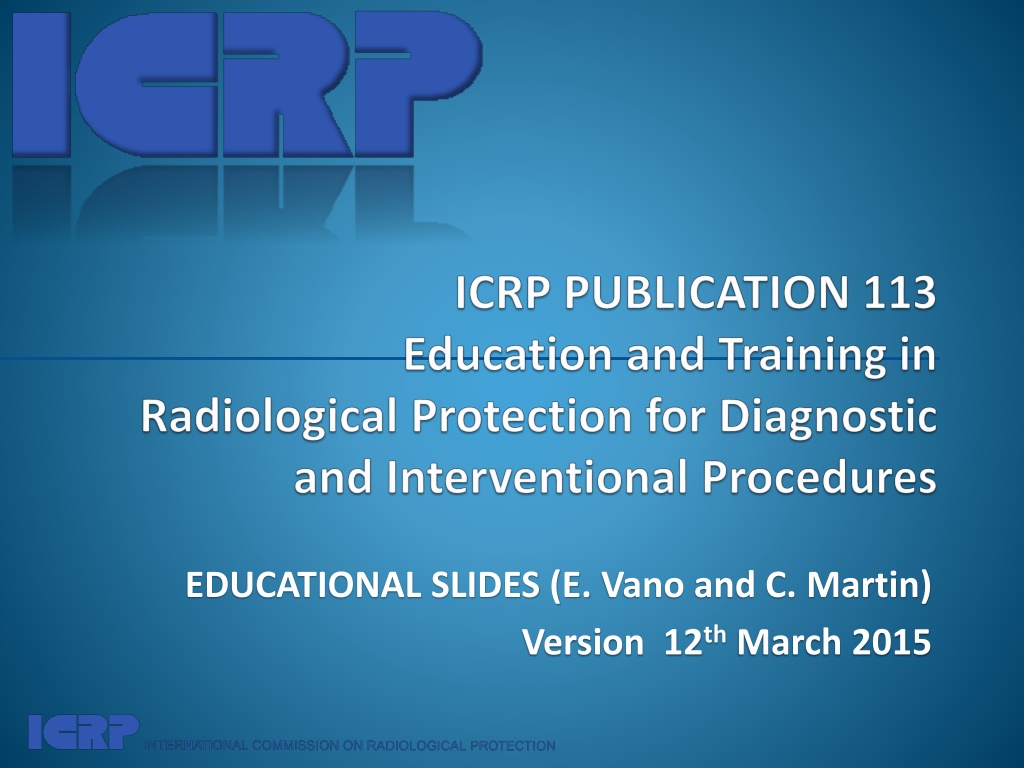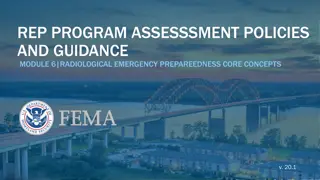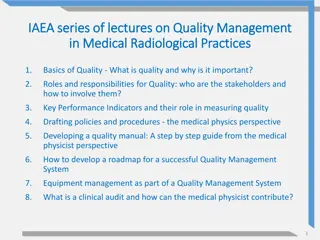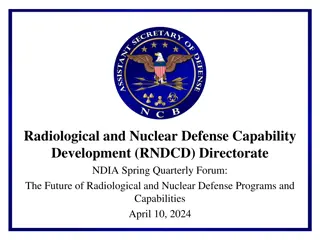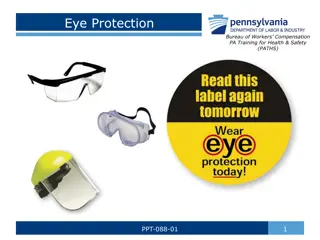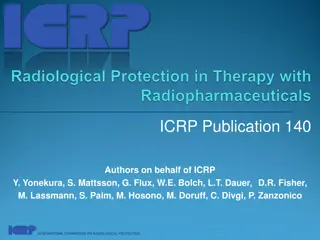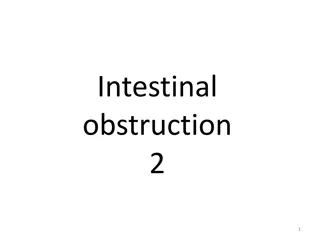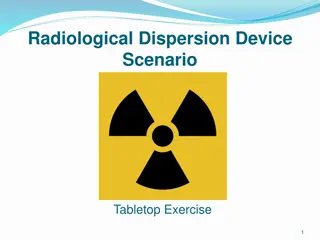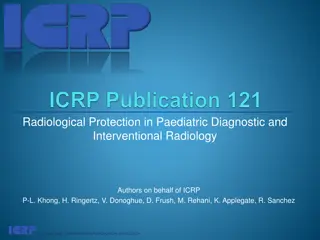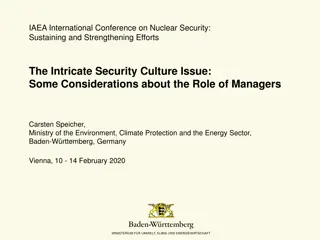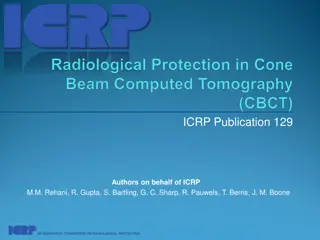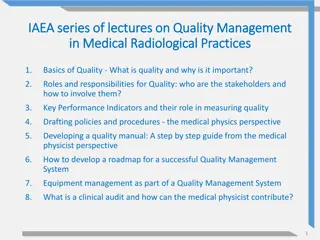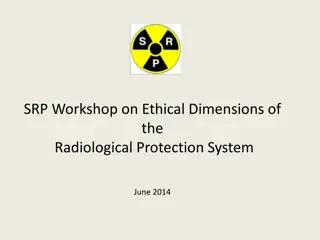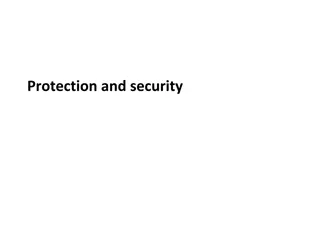Comprehensive Recommendations for Radiological Protection Education and Training
This document provides detailed guidelines for educating and training healthcare professionals involved in diagnostic and interventional procedures using ionizing radiation. It emphasizes the increasing importance of radiation protection knowledge in light of the growing number of such procedures. The report covers topics such as training priorities, methodologies, certification, and specific educational objectives, catering to regulators, health authorities, medical institutions, industry stakeholders, and academic bodies. Accreditation and certification processes are also discussed. The importance of justifying medical exposures based on patient management is highlighted throughout.
Download Presentation

Please find below an Image/Link to download the presentation.
The content on the website is provided AS IS for your information and personal use only. It may not be sold, licensed, or shared on other websites without obtaining consent from the author. Download presentation by click this link. If you encounter any issues during the download, it is possible that the publisher has removed the file from their server.
E N D
Presentation Transcript
EDUCATIONAL SLIDES (E. Vano and C. Martin) Version 12thMarch 2015
Authors: E. Va o, M. Rosenstein, J. Liniecki, M. Rehani, C.J. Martin, R.J. Vetter Editor C.H. CLEMENT Approved by the Commission in October 2010. Please cite this report as ICRP, 2009. Recommendations of the International Commission on Radiological Protection. ICRP Publication 113, Ann. ICRP 39 (5) 2
The number of diagnostic and interventional medical procedures using ionising radiations is rising steadily, and procedures resulting in higher patient and staff doses are being performed more frequently. As such, the need for education and training of medical staff (including medical students) and other healthcare professionals in the principles of radiation protection is even more compelling than in the past. The Commission expands considerably in this publication the basic recommendations on radiological protection education and training with regard to various categories of medical practitioners and other healthcare professionals who perform or provide support for diagnostic and interventional procedures utilising ionising radiation. 3
The document is for use by: cognisant regulators, health authorities, medical institutions, and professional bodies with responsibility for radiological protection in medicine; the industry that produces and markets the equipment used in these procedures; and universities and other academic institutions responsible for the education of professionals involved in the use of ionising radiation in health care. In the context of this publication, the term education refers to imparting knowledge and understanding on the topics of radiation. The term training refers to providing instruction with regard to radiological protection. Advice is also provided on the accreditation (an organisation has been approved by an authorised body to provide education or training) and certification (an individual medical or clinical professional has successfully completed the education or training). 4
INTRODUCTION HEALTHCARE PROFESSIONALS TO BE TRAINED PRIORITIES IN TOPICS TO BE INCLUDED IN TRAINING TRAINING OPPORTUNITIES AND SUGGESTED METHODOLOGIES CERTIFICATION OF TRAINING 1. 2. 3. 4. 5. ANNEX A. EXAMPLES OF SUGGESTED CONTENT FOR TRAINING COURSES ANNEX B. OUTLINE OF SPECIFIC EDUCATIONAL OBJECTIVES FOR PAEDIATRIC RADIOLOGY. ANNEX C. EXAMPLES OF SOME SOURCES OF TRAINING MATERIAL. ANNEX D. REFERENCES CONTAINING INFORMATION OF INTEREST. 5
The basic rule in prescription of any medical exposure is that it must be justified in terms of the influence it will have on the management of the patient, and this should always be followed. It is important that the medical profession and other healthcare professionals understand the hazards from radiation in order to avoid the creation of unnecessary risks to the population as a whole. Lack of knowledge may result in more ionising radiation imaging tests being requested when other non-radiation tests could be performed or when different lower-dose imaging tests could be carried out. This is particularly important for computed tomography scans which involve relatively high doses to patients. 6
There should be RP training requirements for physicians, dentists, and other health professionals who request, conduct, or assist in medical or dental procedures that utilise ionising radiation in diagnostic and interventional procedures, nuclear medicine, and radiation therapy. The final responsibility for the radiation exposure lies with the physician or other regulated healthcare practitioner providing the justification for the exposure being carried out, who therefore should be aware of the risks and benefits of the procedures involved. 7
Education in RP needs to be given to referrers of imaging techniques using ionising radiation, and to medical and dental students. Referrers need to be familiar with referral criteria appropriate for the range of examinations that they are likely to request. The Commission recommends that a stronger emphasis should be placed on transfer of knowledge of RP and its application to referrers. This recommendation applies particularly to practitioners and medical specialists outside radiological specialisations. Since all medical professionals are likely to refer for medical exposures, the Commission recommends that basic education in RP for physicians should be given as part of the medical degree. 8
Professionals involved more directly in the use of ionising radiation should receive education and training in RP at the start of their career, and the education process should continue throughout their professional life as the collective knowledge of the subject develops. It should include specific training with a component relating to RP aspects as new equipment or techniques are introduced into a centre. These staff should be registered on a continuing professional development scheme. 9
Interventional procedures can involve high doses of radiation, and the special radiological risk needs to be taken into account if deterministic effects on the skin are to be avoided. ICRP Publication 85 ICRP proposed a second level of RP training for interventional radiologists and cardiologists, in addition to the training recommended for other physicians who use X-rays. This should also be applied to other medical doctors conducting interventional fluoroscopy-guided procedures (e.g. vascular surgeons). 10
Training in RP given to interventional cardiologists and other medical doctors fluoroscopy-guided procedures (e.g. vascular surgeons) in most countries is limited. Dentists undertake the roles of referrer, practitioner and operator when taking X-rays and training in RP is still missing in some countries. The Commission considers that provision of more RP training for these groups should be a priority. conducting interventional 11
Medical physicists working in RP, nuclear medicine, and diagnostic radiology should have the highest level of training in RP as they have additional responsibilities as trainers in RP for most clinicians. Medical physicists should have proven knowledge and professional competency by way of professional certification or state registration before they are allowed to practice independently and to teach other medical professionals. They should also enter into a continuing professional development scheme. 12
Nurses and other healthcare professionals assisting in fluoroscopic procedures require knowledge of the risks and precautions to minimise their exposure and that of others. Radiographers, nuclear medicine technologists and X- ray technologists will all require substantial training in RP as this represents a core aspect of their work and they will contribute to the training of others. 13
Maintenance engineers and applications specialists currently receive some training in RP, but this may be primarily focused on RP of staff. Training on RP of patients needs to be expanded, particularly in relation to CT, digital radiology and new equipment. The Commission recommends training for radionuclide laboratory staff related to their practice. This may be of rather longer duration as staff members may work with radionuclides on a full-time basis. Radiopharmacists should also be trained in basic aspects of RP and the importance of accuracy in activity of the sources, avoiding contamination. mistakes and limiting 14
It is essential that courses on RP for medical professionals are perceived as relevant and necessary, and only require a limited time commitment so that individuals can be persuaded of the advantages of attending. Training activities in RP should be followed by an evaluation of the knowledge acquired from the training programme. This will allow the accreditation of the training for the attendants. Basic details should be given in the diplomas or certificates awarded to those attending a training programme in RP. Education and training in RP should be complemented by formal examination systems to test competency before the person is awarded certification. 15
If certification in RP is required for some practices (e.g. interventional cardiology) the certificate should be obtained before a professional is involved in practising the specialty at a specific centre. If the requirement is introduced in a country once the professionals are already working in the specialty, the different healthcare providers will need to make the resources available to train their own professionals in RP. Part of the follow-up to maintain the accreditation of organisations providing training should be analyses of results from surveys of participant responses at the end of training courses or training activities. 16
Training programmes need to be devised for a variety of different categories of medical and clinical staff with greater or lesser involvement with medical exposures. Training for healthcare professionals in RP should be related to their specific jobs and roles. A key component in the success of any training programme is to convince the engaged personnel about the importance of the principle of optimisation in RP so that they implement it in their routine practice. In order to achieve this, the training material must be relevant and presented in a manner that the clinicians can relate to their own situation. 17
Priority topics to be included in the training will depend on the involvement of the different professionals in medical exposures. A useful orientation on some of the topics to be included in the education programme on RP for medical students could be ICRP Supporting Guidance 2, Radiation and your patient: a Guide for medical practitioners. A training programme in RP for healthcare professionals has to be oriented towards the type of training to which the target audience is accustomed. Practical training should be in a similar environment to that in which the participants will be practising. 18
The need for adequate resources for education and training in RP for future professional and technical staff that request or partake in radiological practices in medicine must be recognised. Training programmes should include initial training for all incoming staff, regular updating and retraining, and accreditation of the training. The minimum requirements for accreditation of a training programme should take account sufficient administrative support; guarantees for the archiving of files, diplomas, etc. for a minimum number of years; sufficient didactic support; teachers qualified in the topics to be taught and with experience in hospital medical physics; instrumentation for practical exercises; and availability of clinical installations for practical sessions. 19
The primary trainer in RP should be a person who is an expert in RP in the practice with which he or she is dealing. This means a person who, in addition to having a detailed understanding of radiological protection, has knowledge about the clinical practice in the use of radiation. Lecturers in training courses should be competent in RP; this is best demonstrated by professional certification, state registration, or an recognition system. They must also have experience in RP in medical installations and in practical work in a clinical environment (e.g. radiologists, cardiologists, radiographers, etc.). equivalent professional medical physicists, 20
Training of those using radiation imaging equipment should be provided by a team involving radiological professionals, each of whom bring their specific knowledge. Trainers participating in these activities should meet the local requirements and demonstrate sufficient knowledge in the RP aspects of the procedures performed by the medical specialists involved in the training activity. It may be worthwhile for organisations to develop online evaluation systems because of the magnitude of the requirement for RP training. The Commission is aware that such online methods are currently available mainly from organisations that deal with examinations carried out on a large scale. The development of self-assessment examination systems is also encouraged. 21
Lectures professional bodies, universities, and other medical institutions will play a key role in enabling continuing professional development. With many medical schools using computer-based tools for their curricula as well as continuing education, it seems reasonable that the same approach could be employed for continuing education on radiation biology and radiation exposures in medicine. RP training should be updated when there is a significant change in radiology technique or radiation risk, and at intervals not exceeding 36 months. and training programmes organised by 22
RP education and training for medical staff should be promoted by the regulatory and health authorities, and by professional bodies and scientific societies. RP education programmes should be implemented by healthcare providers and universities and coordinated at local and national levels to provide courses based on agreed syllabuses and similar standards. 23
Education and training should be given at medical schools during the medical studies and later, appropriate to the role of each category of physician, during the residency, and in focused specific courses. There should be an evaluation of the training, and appropriate recognition completed the training successfully. In addition, there should be corresponding RP training requirements for other clinical personnel that participate in the conduct of procedures utilising ionising radiation, or in the care of patients undergoing diagnoses or treatments with ionising radiation. that the individual has 24
Regulatory and health authorities have the capability to enforce some levels of RP training and certification for those involved in medical exposures, and to decide if a periodic update could be necessary for some groups of specialists. They also have the capacity to direct resources for these training programmes, to promote and co-ordinate the preparation of training material, and, in some cases, to maintain a register of the certified professionals. 25
Critical issues that have to be taken into account by the regulatory bodies and health authorities when requiring certification in RP for medical professionals are the available infrastructure for organisation of the training programmes and the financial requirements. Staff from the regulatory authority will need to receive a limited amount of RP training. This should include aspects of optimisation and practical RP. 26
Scientific and professional societies should contribute to the development of syllabuses to ensure a consistent approach, and to the promotion and support of education and training. Scientific congresses should include refresher courses on RP, attendance at which could be a requirement for continuing professional development for professionals using ionising radiation. The Commission urges professional societies for relevant medical and RP staff to work together to develop continuing education in collaboration with healthcare providers. Professional bodies are encouraged to promote lectures on RP relevant to their specialty in medical congresses to facilitate continuing professional development. 27
The radiology equipment manufacturers have an important role to play in RP training for new technologies. The radiology industry should produce training material in parallel with the introduction of new x-ray or imaging systems to promote the advances in RP of patients. The equipment manufacturers should alert operators about the impact of their technologies on patient doses if the equipment is not used properly. 28
Equipment manufacturers have a responsibility to develop and make available appropriate tools that are built into radiological equipment to facilitate easy and convenient determination and recording of exposure with reasonable accuracy. Equipment manufacturers maintenance engineers with responsibilities for imaging systems and clinical applications specialists have training in RP of patients. It is important that they understand how the settings of the x-ray systems and adjustments that they may make influence the radiation doses to patients. should ensure that 29
Category 1 radiologists: physicians who are going to take up a career in which the major component involves the use of ionising radiation in radiology. This includes those performing interventional radiology procedures. Category 2 nuclear medicine specialists: physicians who are going to take up a career in which the major component involves the use of radiopharmaceuticals in nuclear medicine for diagnosis and treatment including PET or PET/CT. Category 3 cardiologists and interventionalists from other specialties: physicians whose occupation involves a fairly high level of ionising radiation use, although it is not the major part of their work, such as interventional cardiologists. The specialties involved vary around the globe, but may include vascular surgeons and neurosurgeons. 30
Category 4 other medical specialists using x rays: physicians whose occupation involves the use of x-ray fluoroscopy in urology, gastroenterology, orthopaedic surgery, neurosurgery, or other specialties. Category 5 other medical specialties using nuclear medicine: physicians whose prescription and use of a narrow range of nuclear medicine tests. Category 6 other physicians who assist with radiation procedures: physicians such as anaesthetists who have involvement in fluoroscopy procedures directed by others, and occupational health physicians who review records of radiation workers. occupation involves 31
Category 7 dentists: dentists who take and interpret dental x-ray images routinely. Category 8 medical referrers: physicians who request examinations and procedures involving ionising radiations, and medical students who may refer for examinations in the future. Category 9 medical physicists: medical physicists specialising in RP, nuclear medicine, or diagnostic radiology. 32
Category 10 radiographers, nuclear medicine technologists, and x-ray technologists: individuals who are going to take up a career in which a major component is involved with operating and/or testing x-ray units, including those carrying out some tests on a range of x- ray units in different hospitals and operating radionuclide imaging equipment. Category 11 maintenance engineers and clinical applications specialists: individuals with responsibilities for maintaining the x-ray and imaging systems (including nuclear medicine), or advising on the clinical application of such systems. 33
Category 12 other healthcare professionals: other professionals such as podiatrists, physiotherapists, and speech therapists who may be involved in the use of radiology techniques to assess patients. Category 13 nurses: nursing staff and other healthcare professionals assisting in diagnostic and interventional x- ray fluoroscopy procedures, administration, or the care of nuclear medicine patients. Category 14 dental care professionals: dental hygienists, dental nurses, and dental care assistants who take dental radiographs and process images. radiopharmaceutical 34
Category 15 chiropractors: chiropractors and other healthcare professionals who may refer for, justify, and take radiographic exposures. Category 16 radiopharmacists and radionuclide laboratory staff: radiopharmacists and individuals who use radionuclides for diagnostic purposes such as radioimmunoassay. Category 17 regulators: individuals with responsibility for enforcing ionising radiation legislation. 35
